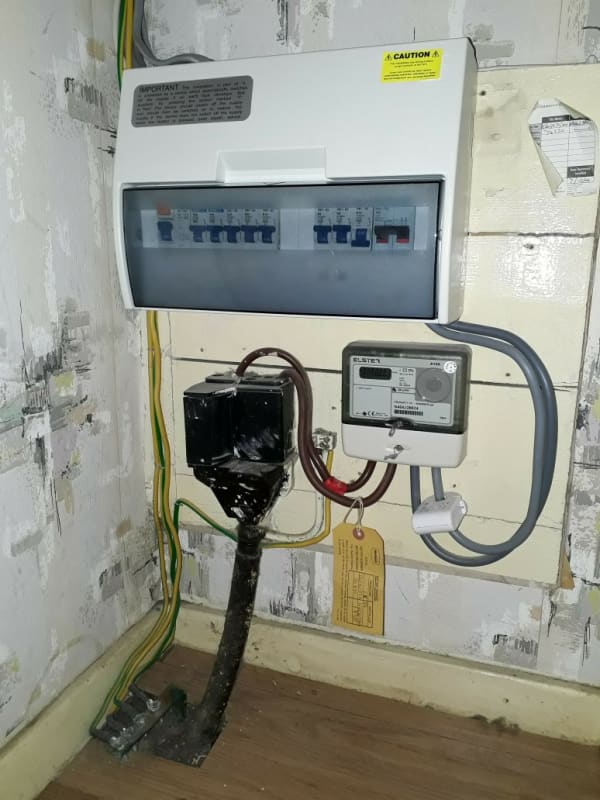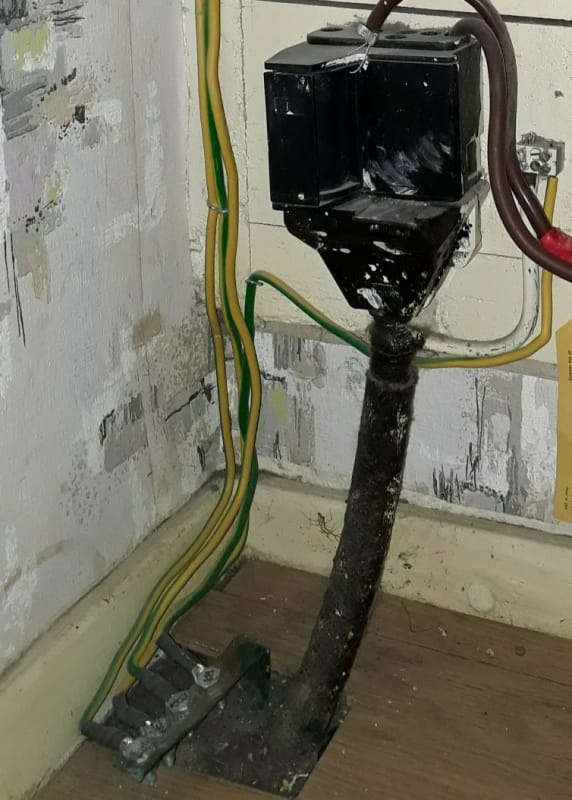gwolf2
Aerospace
- May 15, 2008
- 273
I have recently bought a 1960's bungalow in the UK which has a highly unusual (but probably safe) 240v electrical wiring arrangement. I thought I'd check with some experts before ripping 50% of it out. I have had no luck polling local electricians who either don't know or don't want to get involved. I have an electrical inspection certificate from 2013 but that electrician is no longer around. It's an interesting case so please read on.
Basically the house has a HUGE secondary earthing circuit independent of the normal 3 core ring main. It seems to be applied to everything but the lighting circuits (although I may simply not have found those wires yet). Every wall outlet socket has the normal 3 core ring main including earth AND a second independent earth wire which leads up into the loft and is attached to two 6ft long 2 inch x 1/4 inch copper bus-bars mounted on the roof beams. All meticulously executed and labelled. Furthermore every piece of water and gas pipe in every room has the same. The wires are fairly high capacity, of the order of 6-10 mm^2 cross section and there are about 40 connected by large bolts to the bus-bar. There are also 4 large wires of the order of 10mm^2 bolted to a copper plate in the floor near the incoming meter. Wow.
My gut feeling is that the previous owner (a now deceased ex Marconi worker) was a bit odd and/or had once had a bad experience with electricity. Maybe he was trying to create some sort of Faraday cage to protect his mind from cosmic rays or cold war death rays? I noticed an Ethernet connection in the spacious but otherwise basic loft which would be slightly unusual for a retiree of that generation. It is rumoured by neighbours that he used to have a lot of computers up there and 'worked from home', which I find highly unlikely. Maybe he needed an exceptionally clean or stable electrical supply for something? I have not yet found any high powered supply wires to the loft or anywhere else to indicate high power kit he may have been running.
I noticed an Ethernet connection in the spacious but otherwise basic loft which would be slightly unusual for a retiree of that generation. It is rumoured by neighbours that he used to have a lot of computers up there and 'worked from home', which I find highly unlikely. Maybe he needed an exceptionally clean or stable electrical supply for something? I have not yet found any high powered supply wires to the loft or anywhere else to indicate high power kit he may have been running.
Anyway. Has anyone seen anything like this before, for which there may be a legitimate reason, and which might still be applicable to the property?
All comments welcome before I gradually remove all of these extra earths.
Regards,
Gwolf
Basically the house has a HUGE secondary earthing circuit independent of the normal 3 core ring main. It seems to be applied to everything but the lighting circuits (although I may simply not have found those wires yet). Every wall outlet socket has the normal 3 core ring main including earth AND a second independent earth wire which leads up into the loft and is attached to two 6ft long 2 inch x 1/4 inch copper bus-bars mounted on the roof beams. All meticulously executed and labelled. Furthermore every piece of water and gas pipe in every room has the same. The wires are fairly high capacity, of the order of 6-10 mm^2 cross section and there are about 40 connected by large bolts to the bus-bar. There are also 4 large wires of the order of 10mm^2 bolted to a copper plate in the floor near the incoming meter. Wow.
My gut feeling is that the previous owner (a now deceased ex Marconi worker) was a bit odd and/or had once had a bad experience with electricity. Maybe he was trying to create some sort of Faraday cage to protect his mind from cosmic rays or cold war death rays?
Anyway. Has anyone seen anything like this before, for which there may be a legitimate reason, and which might still be applicable to the property?
All comments welcome before I gradually remove all of these extra earths.
Regards,
Gwolf

![[lol] [lol] [lol]](/data/assets/smilies/lol.gif) "Sounds like the kind of lunacy that the 'audiophile' community periodically embark upon". There is a high end audio store near me that sell $30k speaker wires. I've even tried to get them explain how speaker cable has a direction (arrows) listed.
"Sounds like the kind of lunacy that the 'audiophile' community periodically embark upon". There is a high end audio store near me that sell $30k speaker wires. I've even tried to get them explain how speaker cable has a direction (arrows) listed. ![[bigsmile] [bigsmile] [bigsmile]](/data/assets/smilies/bigsmile.gif)


